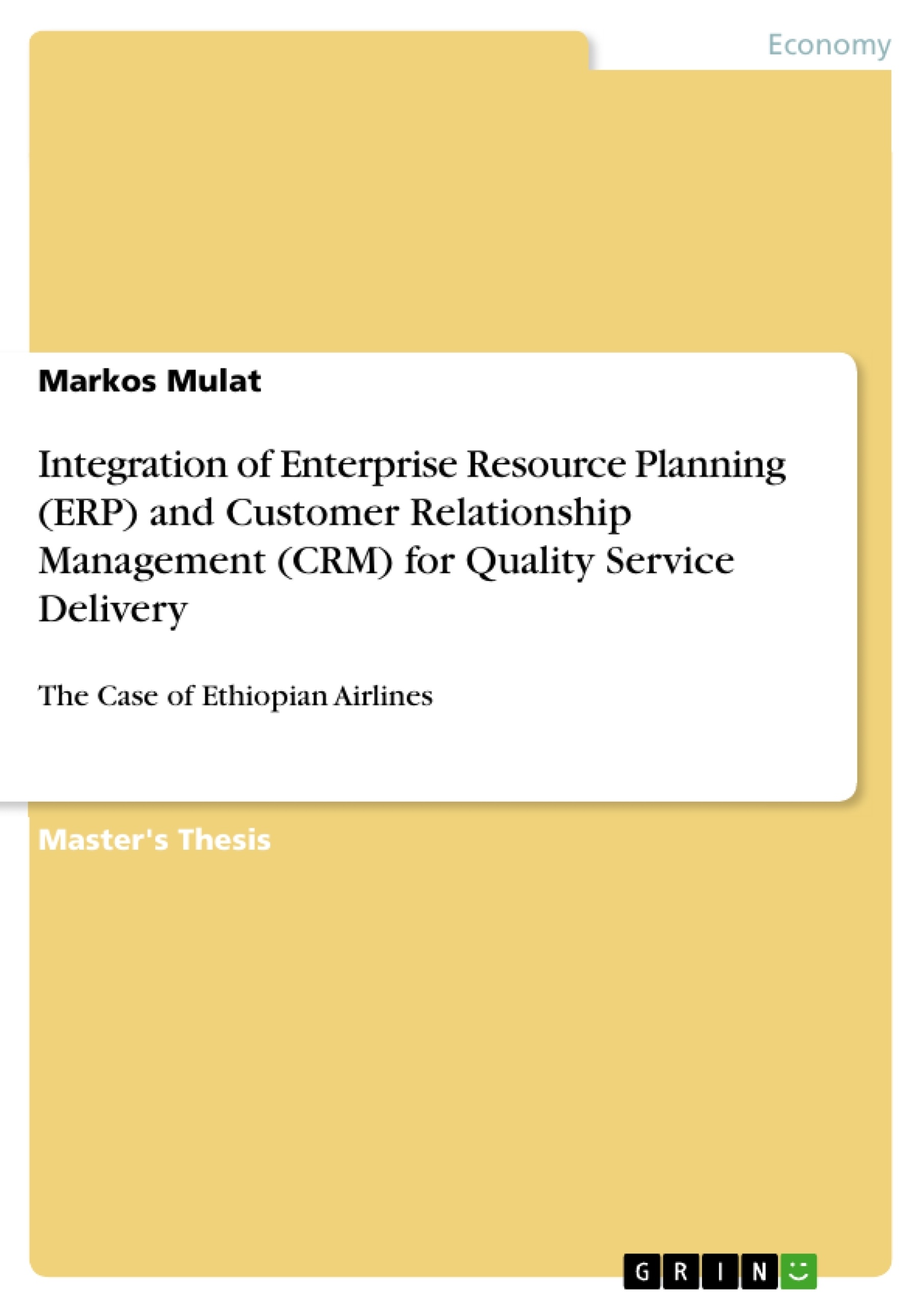Service quality and customer satisfaction are very important concepts that companies must understand in order to remain competitive in business and hence grow and in the process of delivering quality service, technology plays a larger role. The purpose of this study was to explore the achievements, pinpoint the challenges and scrutinize the prospects of integrating Enterprise Resource Planning (ERP) & Customer Relationship Management (CRM) and analyze their impact on quality service delivery in Ethiopian Airlines. A structured questionnaire was designed, pretested, modified, and self-distributed to senior executives, employees and customers of the company to capture data. A total sample of 165 were taken as a respondent.
Out of these, 115 were employees of the company and 50 were customers who have made a flight with Ethiopian airlines on any route. Quantitative & qualitative techniques were selected to collect the data. Non-probability purposive sampling was used during the selection of the sample. The SPSS computer package was used to analyze the collected data. Feedbacks received from 84 employees and 45 customers were analyzed & the response rate was 73.1 and 90 percent respectively. The analysis of employee responses revealed that the integrated systems has improved various functions of different department in the company by acting as a catalyst to support the tactical planning processes, ensures the right number and kinds of people at the right place and right time, reduced the financial cycle closing time and improve the supply chain performance by adding value to the company.
In addition, since the integration, the company is enjoying the ultimate benefit of all-in-one system that can decrease errors, lower cycle times, reduces turnaround time, and support management decisions. The findings also indicated that delivering high quality service increase customer satisfaction, which in turn leads to high level of customer commitment and loyalty. Several challenges were also pointed out among which included lack of finance to update and maintain the systems, lack of expertise in IT to operate the systems, lack of training and development of staff on the systems. The study also assessed the perception of the customers about the quality of the service delivered by the Ethiopian Airlines by using five dimensions of the SERVQUAL model.
Inhaltsverzeichnis (Table of Contents)
- Chapter One: Introduction
- 1.1. Background of the Study
- 1.2. Background of the Organization
- 1.3. Statement of the Problem
- 1.4. Research Questions
- 1.5. Objectives of the Study
- 1.5.1. General Objective
- 1.5.2. Specific Objectives
- 1.6. Significance of the Study
- 1.7. Scope of the Study
- 1.8. Organization of the Research
- Chapter Two: Literature Review
- 2.1. Introduction
- 2.2. Enterprise Resource Planning (ERP)
- 2.2.1. Definitions of ERP
- 2.2.2. Historical Overview of ERP
- 2.2.3. ERP Modules
- 2.2.4. Benefits of ERP Implementation
- 2.3. Customer Relationship Management (CRM)
- 2.3.1. Concepts of CRM
- 2.3.2. Evolution of CRM
- 2.3.3. Types of CRM
- 2.3.4. Benefits of CRM Implementation
- 2.4. ERP and CRM Integration
- 2.4.1. Types of ERP and CRM Integration
- 2.4.2. Benefits of ERP and CRM Integration
- 2.4.3. Challenges of ERP and CRM Integration
- 2.5. Service Concept
- 2.5.1. Service Quality
- 2.5.2. Dimensions of Service Quality
- 2.5.3. Service Quality Models
- 2.5.4. Service Quality in Airline Industries
- 2.5.5. Role of ERP and CRM Integration in Quality Service Delivery
- 2.6. ERP and CRM Software Vendor Profiles
- 2.7. Conceptual Framework
- Chapter Three: Research Methodology
- 3.1. Introduction
- 3.2. Research Design
- 3.3. Study Population
- 3.4. Sample Size and Sampling Technique
- 3.5. Sources of Data
- 3.5.1. Primary Data Source
- 3.5.2. Secondary Data Source
- 3.6. Data Collection Instruments
- 3.6.1. Primary Data Collection Instruments
- 3.6.1.1. Semi-structured Interview
- 3.6.1.2. Questionnaire
- 3.7. Procedures of Data Collection
- 3.8. Methods of Data Analysis
- 3.9. Ethical Considerations
- 3.10. Reliability and Validity
Zielsetzung und Themenschwerpunkte (Objectives and Key Themes)
This thesis aims to analyze the integration of Enterprise Resource Planning (ERP) and Customer Relationship Management (CRM) systems within Ethiopian Airlines to assess their impact on quality service delivery. The study investigates the achievements, challenges, and future prospects of this integration, drawing on both theoretical frameworks and empirical data.
- Integration of ERP and CRM Systems
- Impact on Quality Service Delivery
- Achievements, Challenges, and Prospects of Integration
- Application of Theoretical Frameworks
- Analysis of Empirical Data
Zusammenfassung der Kapitel (Chapter Summaries)
Chapter One introduces the research topic, providing background information on the study and the organization, Ethiopian Airlines. It outlines the problem statement, research questions, objectives, significance, scope, and organization of the research.
Chapter Two presents a comprehensive literature review, defining ERP and CRM systems and examining their historical development, modules, benefits, and challenges. It explores the concept of service quality, including its dimensions, models, and application in the airline industry. The chapter also discusses the integration of ERP and CRM systems, including its types, benefits, and challenges, and analyzes the role of integration in delivering quality service. Finally, it provides an overview of ERP and CRM software vendors and develops a conceptual framework for the study.
Chapter Three delves into the research methodology, outlining the research design, study population, sample size, sampling technique, data sources, data collection instruments, data collection procedures, and data analysis methods. It also addresses ethical considerations, reliability, and validity of the research.
Schlüsselwörter (Keywords)
The key terms and focus topics of this thesis include ERP integration, CRM integration, service quality, Ethiopian Airlines, quality service delivery, achievements, challenges, prospects, theoretical frameworks, empirical data, and research methodology.
- Citar trabajo
- Markos Mulat (Autor), 2016, Integration of Enterprise Resource Planning (ERP) and Customer Relationship Management (CRM) for Quality Service Delivery, Múnich, GRIN Verlag, https://www.grin.com/document/383759



